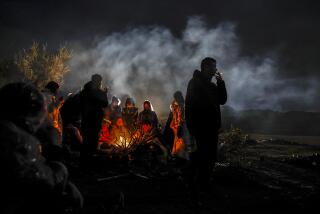Putting a Human Face on Tragedy
A 25-year-old woman whose husband died last year trying to cross the border from Mexico has lent her face and story to the Immigration and Naturalization Service in an attempt to prevent similar tragedies.
“My two sons are going to grow up without their father,” says Los Angeles native Jackie Gallegos, cradling her 8-month-old son, in one of a series of public service announcements unveiled Thursday. “He died trying to come into the United States illegally. What makes it even sadder is it didn’t have to happen.”
The INS is hoping that the first-time participation of someone directly hurt by a border-related death will add credibility to the 1-year-old campaign.
The 30-second spots are available in Spanish for use in Mexico and some Central American countries, officials said at a Los Angeles news conference. Both English- and Spanish-language versions will be distributed in the United States.
The effort is part of the Border Safety Initiative, launched last summer with the cooperation of Mexico, to reduce the number of deaths among illegal border crossers.
The program, which includes warning signs near the border and rewards for those who turn in smugglers of immigrants, came amid concern over the rising death toll among crossers, who often drown or succumb to extreme heat. Because temperatures in the desert Southwest exceed 100 degrees in the summer, national Border Patrol chief Gus de la Vina said, “We’re trying to get the [announcements] out now.”
Immigrant rights advocates have blamed the increasing number of deaths on a U.S. crackdown around San Diego that has spurred the use of dangerous routes in mountains and deserts to the east. De la Vina instead blamed the smugglers who choose such routes and often leave the immigrants behind.
A smuggler left Gallegos’ husband, Julio, and 10 others to perish in the desert near El Centro. Their bodies were found in August. Jackie Gallegos said her husband had illegally crossed the border earlier to settle here. The couple, who met and married in Los Angeles, had always wanted to adjust his immigration status, she said, but the small immigrant assistance operations they would turn to charged large amounts of money even to begin the process. So they delayed it.
Julio Gallegos had returned to Mexico in January 1998 to visit his ailing father. He later hired a smuggler to return to his wife, who was pregnant with their second child.
Fifty people have died so far this year crossing illegally into California, but Border Patrol officials said 150 others have been rescued.
Still, Claudia Smith of the California Rural Legal Assistance Foundation in Oceanside, said, “You can warn people, but how are you going to stop thousands of people who . . . see coming north as their only option?”
More to Read
Start your day right
Sign up for Essential California for news, features and recommendations from the L.A. Times and beyond in your inbox six days a week.
You may occasionally receive promotional content from the Los Angeles Times.






